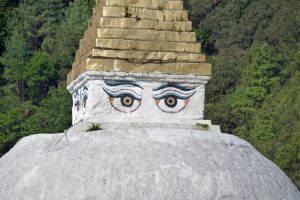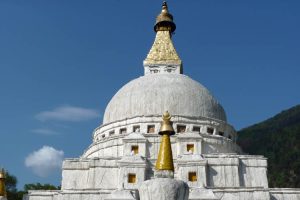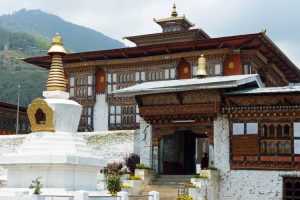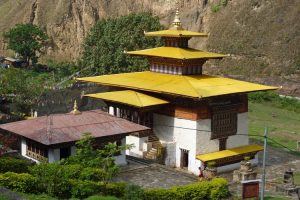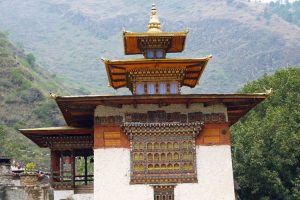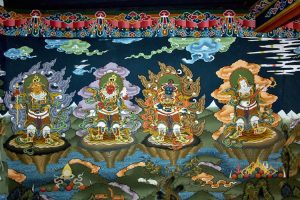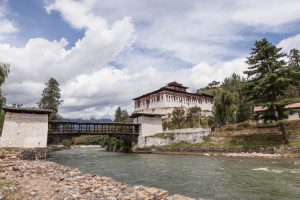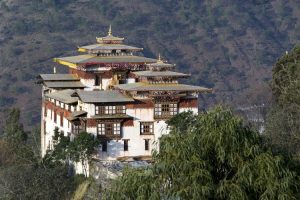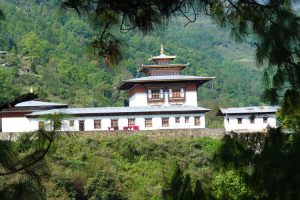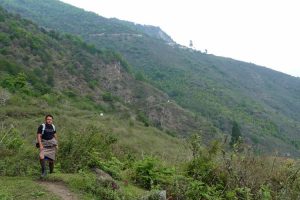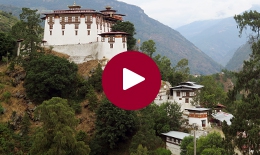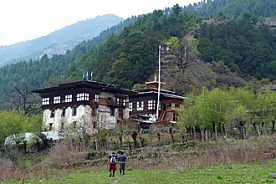
- Grade:
-
?
Gentle
Suitable for people who enjoy easy-paced walks or exploring the countryside on foot.
Find out more...
Gentle
-
?
- Duration: 19 days from the UK
- Walks on: 1 day
- Private Departures Available
Flight inclusive from £5645, Land only from £4695
Explore the mysterious eastern corner of the Thunder Dragon Kingdom, walk to remarkable hill-top dzongs and remote villages, and watch masked dancers at a traditional festival.
Highlights
- Explore the spectacular and little visited hill-top towns and temples of east Bhutan.
- Visit the picturesque village of Ura and stay in a traditional farmhouse for one night.
- Cross the high Thrumshing La on an exciting drive to Mongar.
- Enjoy gentle walks in the beautiful valleys around Bumthang.
We are delighted to offer this holiday exploring some of the spectacular but lesser visited highlights of the Thunder Dragon Kingdom. Although this is a fabulous trip in its own right, it would also be an ideal itinerary for anyone looking to return to Bhutan for a second visit to see more of the country’s unique culture and landscape.
The distance from east to west of the country is only some 315km as the crow flies, but the mountain road which links the east with the west is one of the great Himalayan road journeys. It snakes its way over high mountain passes and down into deep subtropical valleys, making the actual road journey two or three times that distance. Because of this lengthy road journey the east feels rather remote from the rest of the kingdom and the whole area is still very much 'off-the-beaten' tourist track. The region still has relatively few visitors.
However, now that there is a proper airstrip in central Bhutan at Jakar, and because there are almost daily flights in the spring and autumn (subject to weather and availability), it is now much easier to visit the east of Bhutan. Also, in recent times the government has reduced the Tourist Tax for every night spent in the eastern districts to promote the region. This has made it more affordable, and a visit to the east even more attractive.
In past times the east was controlled from dramatic dzongs such as those in Mongar, Tashigang, Trashiyangtse and Lhuentse. Although the region was linked to the rest of Bhutan by rugged trade routes, the people from here often felt more closely connected with their nearer neighbours in Tibet and India and had important trade and cultural links with them, as well as with the people of western Bhutan. This all contributes to the east having a totally different feel to the rest of the country. It has something of a feel of ‘old Bhutan’ about it. Many of Bhutan’s most important dzongs and monasteries are found in the east, alongside some of the most spectacular scenery in the kingdom. A semi nomadic ethnic group, the Brokpa of Merak-Sakten, live in the wilderness of the far east, and these fascinating folk have some of the wildest supernatural legends of the Himalaya, some still believe that the Migoi (yeti) roam the forests here.
Arriving in Paro you will have time to explore the Paro Valley and then, to reduce the amount of driving necessary to reach the east, you will fly from Paro to Bumthang. You will stay overnight at the picturesque, medievalesque village of Ura in a traditional farmhouse homestay, and then make the spectacular drive over the high Thrumshing La pass and down, down, down, to the river at Kuri Zampa and onto your first town of the east, Mongar. Once in the east you will explore this remote corner of the country with visits to Lhuentse, Trashiyangtse and Tashigang and on walks through the lovely countryside. If you join our autumn departure, you will also attend a traditional Bhutanese tsechu, or festival, one of the undoubted highlights of any visit to this unique Himalayan kingdom. Finally you will drive down to the border with India and fly to Delhi for your flight home.
Private Departures
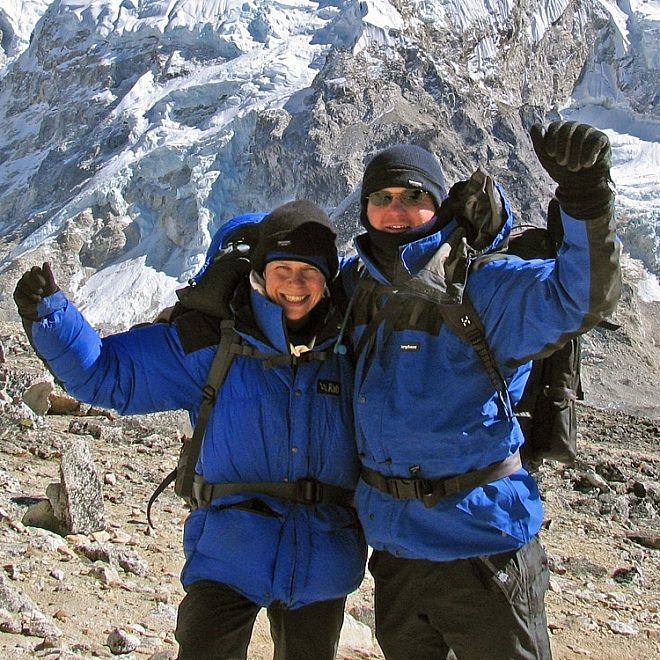
Gentle Walking Eastern Bhutan - Private Departures
If you would prefer to travel just with your partner, friends or family, we can arrange a private departure of this holiday. You follow the same itinerary, but travel on dates that suit you. Alternatively we can include elements of this holiday in a bespoke Tailor Made itinerary. Contact our friendly team for details and prices, and to make a booking.
At a glance
Gentle
Duration: 19 days from the UK
Walks on: 1 day
Max. Altitude: 3,750m/12,303ft, Thrumshingla Pass, Day 8
Private Departures Available
Guaranteed to run for a minimum of 4 clients
Maximum group size: 12
Accommodation types: Hotels, Homestay
Festival:
October departures attends the Jakar Tsechu
Meal arrangements: 16 breakfasts, 14 lunches and 14 dinners are included. Bed and breakfast in Kathmandu and Delhi.
Itinerary overview
| Day | Activity |
|---|---|
| 1-2 | Fly to Kathmandu |
| 3-5 | Fly to Paro. Walk to Taktsang and sightseeing in Paro Valley. |
| 8 | October departure visits Jambay Lakhang Festival in the morning. Drive to near Ura with walk down from pass. |
| 9 | Full day drive to Mongar, crossing the Thrumshing La. |
| 10 | Day walk to Panchula Gompa. Drive to Autsho. |
| 11 | Drive to Khaine Lakhang. Continue to Tangmachu to visit Guru Rimpoche Statue. Drive to Lhuentse Dzong. Visit Khoma village. Return to Autsho. |
| 12 | Excursion to visit Dungkhar Village. Visit palace and lunch with local family. |
| 13 | Drive to Trashigang with visit to Dramatse Monastery. Local walk. |
| 14 | Sightseeing in Trashigang including dzong. Walk to Khapti village. |
| 15 | Drive to Trashiyangtse. |
| 16 | Visit Arts and Crafts Institute. Return to Trashigang with walk on way to Rhadi Village and lunch in farmhouse with local family. |
| 17 | Test test test testing's - & test |
| 18-19 | Drive to Samdrup Jongkhar. Cross into India. Drive to Gauhati. Fly Delhi. Fly to UK. |
Leader: Local leader, Bhutan
You will have an English speaking Bhutanese guide. Mountain Kingdoms have been working with the same partner in Bhutan since 1986. Their guides are some of the best in the Kingdom. They speak fluent English, as this is taught in all Bhutanese schools, and are fully qualified guides. The Tourism Authority of Bhutan insists that a Bhutanese trek or tour leader must pass his/her guiding exams in Thimphu before accompanying groups of foreign visitors. Guides receive regular ‘top-up’ training and 15 of our regular leaders have completed an extended training course run by Mountain Kingdoms in Bhutan.
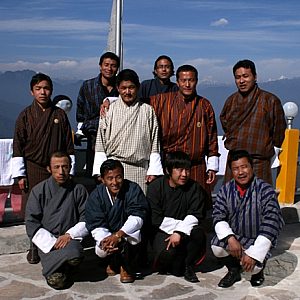
Holiday Itinerary
Day 1 - Fly London to Kathmandu
Depart London on your overnight flight to Kathmandu.

Day 2 - Arrive Kathmandu. Group transfer to hotel.
You will be met on arrival and transferred to your hotel. You might like to venture out to nearby Thamel for your evening meal, or eat in the restaurant if you are tired from your journey.

Day 3 - Fly to Paro - 1hr 15 min flight. Initial sightseeing in Paro Valley.
Transfer for the flight to Paro, the country's main airstrip, 2,250m/7,382ft. The flight often gives fantastic views of the Himalaya including Everest, and particularly exciting is the section through the Bhutanese foothills and the thrilling landing. Try to sit on the left hand side of the plane. On arrival you will be met by your Bhutanese guide and be transferred to your hotel.
The Paro Valley has had a great strategic importance in the history of Bhutan and was in the past an important staging post on the trade routes with Tibet. Paro Dzong, situated on a rocky outcrop above the Paro Chu and with views down both sides of the valley, was historically one of Bhutan's strongest and most strategic fortresses. Before the rebuilding of the Tashichhodzong in Thimphu it was also the seat of Bhutan's National Assembly.
Depending on your flight schedule there may well be time to do some initial sightseeing in the Paro Valley perhaps visiting the impressive Paro Dzong, or the National Museum housed in the old watchtower above the dzong. The museum holds a fantastic collection of Bhutanese national treasures including the King's famous 'dragon hat', a wonderful collection of Bhutanese stamps, highly decorated thangkas (painted religious hangings), statues and weaponry.

Day 4 - Walk to Taktsang, 3,110m/10,203ft - 4-5 hours. Visit Paro Dzong and museum.
This morning you will walk up to the famous Tiger's Nest, Taktsang Monastery. The monastery is perched some 600m/2,000ft up on a cliff overlooking the valley and was said to be where the legendary Indian saint, Guru Padma Sambhava, flew from Tibet on the back of a tiger to defeat five demons, who were opposing the spread of Buddhism in Bhutan. It's a steep uphill walk through woods, of about 1½-2hrs, to reach a tea house (an ascent of 340m/1,115ft). Apart from offering welcome refreshment this tea house is one of the principle viewpoints of the monastery, and those who prefer not to climb any further can relax here whilst others continue on. If there is a particular religious gathering or VIP visit in progress, you will not be able to enter the monastery but the further half an hour's ascent is well worth it in any case, as it brings you to another viewpoint directly across from the monastery. If you are able to make a visit, the final section of the walk takes you from here steeply down approximately 100m/330ft into the gorge that separates you from the monastery and then climbs back up again to reach the monastery gate. You descend back to the valley floor by your outward route back to where your vehicle will be waiting. The full walk to the monastery and back involves approximately 740m/2,428ft of ascent.
In the afternoon you will visit Paro's impressive dzong, one of the most important in the kingdom. Above the dzong is the 17th century watchtower or Ta Dzong. This unusual, circular building houses Bhutan's National Museum and has recently been fully restored. The museum has a fantastic collection of Bhutanese national treasures which you will be able to spend time discovering.

Day 5 - Sightseeing in Paro Valley. Walk to Kyichu Lhakhang - 2 hours. Drive to Drukyel Dzong. Drive towards Chele La Pass and visit Dzong Drakha.
Today you will explore some lesser known corners of the Paro Valley.
Starting directly from the Olathang Hotel, you turn right out of the main gate and climb gradually to the temple at the top of the hill, Tshering Goempa, half an hour from the hotel.. This dates back to the 13th Century and is one of six temples in Bhutan dedicated to six sisters. Tshering means long life and people come to the six temples to pray for long life. Then the path drops down into the forested valley on the other side before climbing up to another temple. It is still in use but sadly neglected. Apparently the restoration has recently been approved. This is the temple to the Second Sister of Long Life and called Tenshea Gompa. From here the walk continues down the hill through Blue Pine Forest to the main valley arriving at Kyichu Lhakhang, half an hour down, two hours in total.
Here you will visit the ancient temple of Kyichu Lhakang, one of the oldest and most beautiful temples in Bhutan. According to tradition the temple, built in the 7th century, is said to have been one of 108 temples built by the famous Tibetan king, Songtsen Gampo, to pin down an enormous demon that was believed to be thwarting the establishment of Buddhism over the whole of Tibet. Only two of the 108 temples exist in Bhutan and you will visit the other one on day 10, Khaine Lakhang, which is rarely visited.
After your visit to Kyichu Lhakhang you meet your transport and drive up the valley to Drugyel Dzong. This castle was built in 1649 during the time that Bhutan was resisting foreign invasion and consolidating its power, and it was an important base for defence of the region right up until 1951 when it was destroyed by fire. It lay derelict until very recent times but has now been fully renovated. From here there are good views to the north and if the skies are clear you can see Mount Chomolhari, the second highest peak in Bhutan.
After lunch, to aid your acclimatisation, you will drive up the road which leads towards the Haa Valley over the Chelela pass. You will not drive as far as the pass but part way you will leave your transport and walk the short distance to the temple of Dzong Drakha, a beautiful cliff temple spectacularly located on a broad ledge, with vertical limestone cliffs above and below and surrounded by forest. This is a tranquil spot and the views over the Paro Valley from here are fantastic. You return by vehicle to Paro after the walk.

Day 6 - Fly to Jakar, Bumthang 2,587m/8,487ft. Gentle walk to local temples.
In the morning you will transfer to the airport to take the short flight to Bumthang. The Bumthang region encompasses four major valleys. Jakar town, where you will stay for two nights, is in the main valley called Chokhor. The other valleys are the Ura Valley to the east, Tang Valley, and Chumey Valley to the west. Bumthang is a very fertile area and is often considered the spiritual centre of the kingdom, being home to some of the country's most historic temples and sacred sites. The area is also of great cultural importance and is famous for its fine weaving. It's said that every home is equipped with a loom for weaving and that young girls are proficient in the craft before they reach the age of twenty.
In the afternoon you make an easy walk to explore some of the temples of the valley. Firstly you either walk or drive to reach Jambay Lhakhang. This is one of the country's oldest temples, built in the mid-7th Century. Look out for the set of three steps in the main temple. The first step, now hidden below floor level, is said to represent the time of the past or 'historical' Buddha. The second, very well worn, step represents the present Buddha, whilst the third step above, is said to represent the age of the future Buddha. The point at which the second step is worn down to ground level is held to be the time when the world as we currently know it will end. From Jambay Lhakhang you walk along a farm track for 30 minutes to reach Kurjey Lhakhang, a series of three large temples. The oldest of the temples here houses a rock indented with the body shape of Guru Rinpoche, whilst the most recent dates back just 30 years and was built by the Queen Mother, Ashi Kesang Wangchuck. Descending from the temples you cross a suspension bridge and walk downstream for a further 45 minutes to Tamshing Lhakhang, the most important Nyingma Gompa in the Kingdom, established in 1501 by Pemalingpa. Inside you can see a suit of chain-mail armour, which Buddhists believe will bring good fortune if worn and then walked around the inner temple three times.
Your transport will meet you outside the gompa and return you to your hotel, with perhaps a stop in Jakar township or a visit to the spectacular Jakar Dzong (Castle of the White Bird), so called because a white bird was supposed to have indicated the most auspicious place to build.
(if the flight from Paro to Bumthang is cancelled for any reason you will drive there instead, over the next two days, arriving on the evening of Day 6)

Day 7 - Walk to Ngang Lhakhang (Swan Temple) - 2½ to 3 hours. Return to Jakar.
In the morning you will visit Ngang Lhakhang, known as Swan Lhakhang. First you drive the short distance to arrive at a long mani wall in Tangbi. You descend to cross the river by a suspension bridge and then make a pleasant walk, up the river valley through forest and meadows to reach Ngang Lhakhang, also known as 'Swan Temple'. This temple has an illustrious history. Guru Rimpoche is said to have visited here and the present temple, built in the 15th century, is said to be named after swans supposedly seen on a nearby lake by the temple's founder, a Tibetan lama named Namkha Samdrup. The custodian of the temple is a man called Sonam Wangyal. His wife's family has looked after the temple since the 14th Century. He was interviewed in 2017 for a film called 'The Lost Kingdom of the Yeti'. Our own MD, Steve Berry, also took part in this film.
You will have a packed lunch at the temple and then after your visit there you descend to cross the river to a road and will meet your vehicle to drive back to Jakar. The afternoon will be at leisure or time for further sightseeing in the valley.

Day 8 - Morning at leisure in Jakar or attend the Jakar Tsechu (October departure). Drive Ura La pass, 3,425m/11,237ft - 2 hours. Easy walk down to Ura village - 1-1½ hours.
The morning will either be at leisure in Jakar or, on the October departure, you will join local people at the Jakar Tsechu held annually at Jakar Dzong. Traditional Bhutanese festivals are great opportunities for the Bhutanese to get together, not only to socialise and have fun, but also because the very act of attending a festival is thought to be a blessing and to confer merit. People from the area visit the festival dressed in their finest clothes to enjoywatching the singing and dancing. Many villagers also take part in the dances. The festival features different masked dances, known as chams, those that are intended to give moral instruction, those designed to drive away evil spirits and those that celebrate the Buddhist faith in its many guises. Watch out for the 'atsaras', clowns who tease both dancers and audience.
Later you will start the spectacular drive to the east. Leaving Jakar township you drive up out of the valley and to a pass above the village of Ura, the Ura La at 3,425m/11,237ft. From here, on a clear day, there are fantastic views of Bhutan's highest mountain, Gangkar Punsum, 7,550m/24,770ft. Here you leave your vehicle and walk down to Ura Village, a pleasant downhill walk through a lovely forest. When you arrive in the extremely picturesque village, you will visit the small village gompa, dedicated to Guru Rimpoche, and will then walk through the medieval looking streets to reach the Bangpa Heritage Farmstay, a large traditional farmhouse offering comfortable if simple accommodation. Meeting the family and experiencing their way of life gives a really good insight of Bhutanese rural life.

Day 9 - Full day drive to Mongar, 1,700m/5,577ft, crossing the Thrumshing La Pass, 3,750m/12,303ft - 180km, 6-7 hours.
Today you drive to Mongar. This is a long but stunning drive of many startling contrasts, crossing one of the highest road passes in Bhutan and passing through alpine scenery and sub-tropical forest and travelling one of the most dramatic and spectacular roads in the kingdom. Leaving Ura to rejoin the main highway, you enter the alpine landscapes of the Thrumshingla National Park, passing beneath overhanging cliffs to reach the Thrumshing La Pass, 3,750m/12,303ft, in about one hour. On a clear day you may be able to see Bhutan's highest peak, Gangkar Punsum, from here. From the pass the road starts its descent, in places hacked into the cliffs, with numerous streams and waterfalls crashing down. Leaving the national park the road emerges into the upper part of the Yong Khola into dense forest, where the scenery becomes lush and sub-tropical with huge trees, bamboos and ferns. This wilderness is one of the prime birdwatching areas in Bhutan. From the forest the road continues to descend through cultivated terraces to arrive at Kuri Zampa bridge, the lowest point of the drive at 570m/1,970ft, an astonishing descent of 3,200m/10,500ft from the Thrumshing La pass. From the bridge, the road climbs up for a further hour through pine forests and cultivated fields to reach Mongar, located on top of the hill.
In common with other towns of east Bhutan, Mongar is not located in a valley as the towns of the west are, but is situated on the top of a hill. There are fine views over the Kuru Chu River and surrounding countryside. Mongar's dzong is relatively new and while the town has busy shops and bars and a bustling fruit and vegetable market there is otherwise not a lot else to see in town.

Day 10 - Walk to Pangchu La Gompa – 2,150m/7,054ft - 3½-4 hours. Return to Mongar and drive to Autsho.
Today you have a very pleasant walk, right out of the front door of the hotel. You climb up past a few houses, with the modern dzong over to your left, and soon emerge into lovely forest and farmland. After about two to three hours walking, alternately in forest and farmland, passing several picturesque farm houses, you arrive at the ridge top, making a final stiff climb of 15 minutes to reach Pangchu La Monastery. This is set right on the ridge line at 2,150m/7,054ft with tremendous all round views, including over to the west to Limithang and the Yongkhola where you travelled from yesterday. About 20 monks live at the monastery and the Lhakhang is well kept with interesting images and wall paintings. From the monastery you continue along the ridge in forest to another small temple about one hour from Pangchu La before making the descent back to Mongar township. Back in town you may visit Mongar's vegetable market and bustling streets.
Later you will drive from Mongar to Autsho, descending in zig zags to the valley and then heaing north up the valley toward Lhuentse.

Day 11 - Visit Khaine Lakhang. Drive to Tangmachu to see giant statue. Visit Lhuntshe Dzong and Khoma Village. Return to Autsho.
Leaving Autsho you drive through some pretty impressive gorges with vertical cliffs, and then, instead of continuing direct to Lhuentse, you turn off to the left and ascend by zig zags high above the valley into the hills, to visit Khaine Lhakhang. Your vehicle will park at one end of the village and you can then walk through to the temple. Khaine Lakhang is an incredibly important small temple, being one of 108 built by the Tibetan King, Songtsen Gampo in AD 659, (like Kyichu Lakhang which you saw near Paro). It is said that three statues flew from here of their own accord to a temple in one of the main valleys of Bumthang. The main protective deity here is a ferocious god named Taxan, who is depicted riding a horse.
From Khaine Lakhang it is a relatively short drive up to Tangmachu, a small village off-the-beaten-track and really quite remote, but nowadays famous as the site of a huge copper/bronze statue of Guru Rinpoche some 173ft high and known as the world's tallest statue of Guru Rimpoche. This statue, consecrated in 2015, was built on the ridge top to keep watch over the village and the surrounding countryside and to bring peace and prosperity to the world and to all sentient beings. The views from the ridge top are tremendous.
From there you will descend back to the main valley and drive to Lhuentse Dzong, 1,409m/4,622ft. The dzong which sits on top of a steep hill commanding an impregnable position was formerly the ancestral home of the kings of Bhutan, with its origins dating back to the seventeenth century when a monastery was founded on the site by Kunga Wangpo. Today Lhuentse Dzong is the administrative and religious centre for the Lhuentse District. The small township which straddles the mountainside below the dzong, with a few shops, bars and a bank, is a pleasant place to explore and to perhaps enjoy a cold soft drink or a beer.
Later you will drive up to visit Khoma village. Khoma is said to be the birthplace of the traditional Bhutanse culture of weaving, and is famous for its traditional intricately handwoven silk cloth called Kishuthara. The women of Khoma work in makeshift textile cottages, weaving the delicate designs and patterns. The high prices of their textiles reflect the immense amount of work and the value that the Bhutanese give to such fine weaving. You will return to Autsho for the night.

Day 12 - Excursion to Dungkar Village (5-6 hours round trip). Visit palace and lunch with local noble family.
Today you will drive north of Lhuentse for about 40 kilometres towards the border with Tibet, to visit the historic village of Dungkhar. In Dungkhar you will visit the impressive 16th century palace, the Jigme Namgyel Naktshang, the ancestral home of the Wangchuk Dynasty, the current royal family of Bhutan. Pema Lingpa's son Kuenga Wangpo settled in Dungkhar and it is through him that the royal family trace their ancestry to this village. Pema Lingpa was a frequent visitor to Dungkhar and built the Goeshog Pang Lhakhang, a temple found a two-hour walk up the valley. Jigme Namgyal, father of the first king, was born here in 1825.
The palace has a scenic backdrop of mountains and is of immense historical significance in the history of Bhutan. A visit here is a glimpse into Bhutan's magical historic past. In time it is hoped to renovate the palace and to turn it into a museum, and that tourism to the area will help to boost the incomes of local people. You will have lunch in the home of a family of the local nobility.
Later you will return to Autsho.

Day 13 - Drive to Tashigang. Visit Dramatse and take local walk en route - 2-3 hours.
Today you will drive to Tashigang. On the way you will take a side trip off the main road and up onto a ridge top at 1,350m/4,429ft, to visit the Monastery of Dramatse. The monastery was founded in 1511 and is one of the largest and most important monasteries of eastern Bhutan. It is particularly famous as being the place where the Nga Cham Drum Dance, which features in tsechus (festivals) all over the country, originates.
There are a couple of options for a day walk near Dramatse. Your guide will advise you which is most suitable for your group.
For the first option, as you drive away from the temple and look down into the main valley, you can see below a series of small villages and hamlets and farmsteads stretching down towards the river far, far below. This first walk starts from a small temple with two prayer poles near Zangkar village and it weaves its way down through the fields, terraces and woodland for 2½ hours to eventually reach the village of Waichure next to the road. However, this path is steep in places and involves a large descent.
Probably the second option is a better choice, taking a trail that starts from near Waichure, ending back at the main road and the village of Thungdari. This walk is very pretty and takes just 1½ hours. You start walking near Waichure, going down steps and across stepping stones to a wall with a night shelter overlooking fields, which is used as a lookout for wild animals. Below is a big house with a double roof painted red and a big mani wall with prayer flags. The path descends, levels out through fir trees and eventually becomes a wide cliff path, offering easy and beautiful walking as it weaves around the mountainside. After an hour you reach a square white chorten and from here you can see down a long way to the road at the very bottom. However your path does not drop steeply - it winds around the mountain, gradually losing height.
Your vehicle will meet you at the bottom, at the village on the main road, and you will continue the drive to Tashigang. As you approach you will spot Tashigang's spectacular dzong set on a ridge high above the river before you ascend to reach the town. Tashigang is an attractive town, the largest in eastern Bhutan, with pretty painted houses, lots of bright bougainvillea and geraniums, and bustling shops and cafes.

Day 14 - Explore Tashigang. Walk out of Tashigang to Kapti Village - about 4 hours. Visit Chador Lhakhang and Mapjung village.
You will have time this morning to explore Tashigang town, visiting the centre of town and the impressive dzong. The centre of Tashigang is clustered round a small central plaza with a large prayer wheel, a bank, a few shops and bars but not much else. Below the plaza is the spectacular Tashigang Dzong, set high above the valley. This dzong was built in the 17th Century to guard against Tibetan invaders and was one of the most strategically important in the country. Today it is the administrative and religious centre of the region.
Later you will take a pleasant walk from Tashigang to the village of Khapti. First you will drive to the high court, a handsome building set a little above the town and from near here take a rocky trail which leads up above the town and then continues through lovely forest with lots of birds and wildlife. After an hour you reach the top of the ascent from the courthouse at a big pile of rocks (some 800ft of height gain). From here you can see Samkhar village opposite with a prominent stupa. To the left on top of a hill, is the village Mukthang Khar looking a little like a fort on a hilltop. At the pile of stones there is one large stone, the top of which is smooth where demons are said come in the night to sharpen their knives. The path now contours around eventually passing some scattered houses and terraced fields to reach Sangkhar Chorten, 1,430m/4,693ft. You have a choice here, you can drop down and around into a side valley to cross a stream and climb up to Khapti village. However, this part of the path is well known for wild boar and instead we suggest the vehicle meets you at Sanghar Chorten and you take the new feeder road round to the village.
You now drive down into the main valley, climb up the other side to visit Chador Lhakhang and perhaps the village of Bartshen Yangka. Chador Lhakhang is named after the god of power, Chana Dorji. There is a new temple and an old temple. The new one has been funded by the followers of a high ranking Nyingmapa Lama, Dzongkher Khendshi Rinpoche. This lama has followers all over the world and has sponsored the huge work of the new temple. There is a special object in the temple - a small statue in a box with the snake coming out of its mouth. Miraculously, it seems to weigh very heavily in the hand. Take a blessing with the object on your head. Walk around the adjoining village of Mapjung. In the shop look out for a bottle of popular wine called Zumzin - a peach wine - the name means 'happy face, wiggly head'! Actually very drinkable!
Return drive to Tashigang.

Day 15 - Drive to Trashiyantse. Visit Gom Kora, Trashiyantse old dzong and Chorten Kora. Visit Bumdeling Wildlife Sanctuary.
Today you drive to Trashiyantse. Firstly you drive down into the valley to cross a bridge and turn north up the valley to Trashiyangtse. On the way you visit the charming little temple of Gom Kora. This lovely little pagoda style temple is located by the side of the river and is one of the prettiest and quirkiest temples in Bhutan. A visit here is great fun. After you have looked inside you then go round behind the temple building where there is a huge water eroded boulder which has various historical associations with Guru Rimpoche. You may join pilgrims to make a sacred circuit of the boulder, attempt to climb it up the so called 'stairway to paradise' or 'staircase of the Dakinis', purify yourself by drinking the sacred water which flows down the rock, or squeeze into a tiny holy cave where, when Guru Rimpoche meditated there, he is said to have encountered a demon in the shape of a cobra. Your guide and driver will enjoy a visit here as much as you do!
You then drive further up the valley to Trashiyangtse at 1,690m/5,546ft, visiting the old dzong on the way, situated above the road a couple of kilometres before you reach the town, as well as seeing an ancient cantilever bridge spanning the river just below. Reaching the town you visit the Chorten Kora, a white Nepali style stupa built in 1740 and one of the great attractions of eastern Bhutan. It is built in the same style as the great stupa at Boudhnath in Nepal, but it's not really very like Boudhnath! The reason for the discrepancy is said to be that a lama who wanted to build a copy of the stupa in Bhutan, made a model of the Boudhnath one by carving its shape into a radish, but the radish unfortunately shrank and distorted before he got it back home! The area surrounding Trashiyangtse still has close contacts with the neighbouring Indian state of Arunachal Pradesh.
While in Trashiyangtse you will also have the opportunity to visit the nearby Bomdeling Visitor Centre, in the Bomdeling Wildlife Sanctuary, which has a small wildlife museum and a deer enclosure. Bomdeling Wildlife Sanctuary is important as it is the easternmost range of the wintering grounds of the endangered Black-necked crane and is also home to many other species of animals and birds. You may also take a walk up the pretty valley above Trashiyangtse.

Day 16 - Visit Arts and Crafts Institue of Zorig Chusum. Return drive to Tashigang with a detour to Radhi Temple. Village walk and lunch at farmhouse.
This morning before leaving Trashiyangtse you might visit the Arts and Crafts Institute of Zorig Chusum where training is given in various skills such as woodcarving and weaving. Here you can see the student craftsmen at work and there may also be the chance to buy some handicrafts.
You then drive back down the valley to Tashigang with a detour on the way to visit Radhi Village. Radhi is famous for its super productive rice fields, the skill of its weavers and its fine textiles. You will visit Radhi Temple and have lunch at a local farmhouse before walking on down to the road.

Day 17 - Drive from Tashigang to Sandrup Jonkhar.
Remember to keep your passport on you today as you may need to show it as you enter the town of Sandrup Jongkhar.
First, leaving Tashigang, you pass through Sherubtse and the campus of the country's premier University College before you climb to the Yongphula Pass, 2,190m/7,185ft. About two to three hours from Tashigang you reach Khaling, where one of the most famous weaving centres in Bhutan is located, providing cloth for the royal family. If the centre is open you may stop for a short visit. It is a further four to five hours drive from here to Samdrup Jongkhar.
There are wonderful views of forested hills and valleys rolling away to the foothills and the Indian plains of Assam State. You can often see Langur monkeys, kingfishers, eagles and other brightly coloured birds along the roadside. The Indian-like border town of Sandrup Jongkhar is literally at the very foot of the Bhutanese foothills and is quite subtropical.

Day 18 - Cross border into India. Drive to Gauhati – 116km, 2 hours. Fly to Delhi, 2hrs 50 mins flight.
After breakfast you will drive to cross the border into India and pick up your Indian transport to drive you to Gauhati. You will immediately be aware of the extreme contrast between these two Himalayan neighbours and will soon find yourself missing the peace and serenity of Bhutan! You drive across the flat plains of Assam through tea plantations, cross the mighty Brahmaputra River and arrive at Gauhati, the largest city in this region of India. From Gauhati you fly to Delhi where you will be met and transferred to your hotel near the airport.

Day 19 - Fly Delhi to London.
After breakfast there will be a group transfer to the airport to fly home.
Map
Map Key
-
 Airport
Airport
-
 Point of interest
Point of interest
-
 Mountain Peak
Mountain Peak
-
 Day walk in this area
Day walk in this area
-
 Flights
Flights
-
 Internal Transfers
Internal Transfers
-
 Trek
Trek
Loading...
Hold your place
Not quite ready to book? Why not call us on +44 (0) 1453 844400 to hold a no obligation place while you make up your mind?
Optional supplements
-
Single Room Supplement
From £510
No Surcharge Guarantee
No surcharges will be applied to your holiday after you book. Prices on this website are updated regularly. The Flight Inclusive holiday price, or Land Only holiday price, will be confirmed to you at the time you make your booking. There will be no surcharges after your booking has been confirmed.
Flight inclusive holidays
The 'flight inclusive' holiday prices shown on this website are based upon our preferred airlines and the best priced economy class fares we are able to secure at the time of publication.
We will be able to advise on fares with alternative airlines, upgrades to Business Class, and the options for flights from regional UK airports, please contact us for more details.
Booking your holiday
-
Deposit
From £400.00
For the majority of our holidays, a deposit payment of £400.00 per person is required to secure your place(s), however a small number of holidays require a higher deposit - please refer to the holiday itinerary for more details. If the holiday departs within 60 days, a deposit of £1,000.00 per person is required.
Book now!
- Book your small group holiday securely online – click the ‘Book’ button next to your chosen departure or visit our How to Book page
- Complete and return a Booking Form available to download here.
- Call us on +44 (0)1453 844400 and one of our travel specialists will talk you through the booking process.
What’s included
- An English-speaking Bhutanese leader
- Economy class return air fares from the UK & UK Departure Tax (flight inclusive only).
- Flights between Kathmandu and Paro with airport transfers
- The flight from Paro to Jakar in central Bhutan
- Single, timed, group airport transfers for international flights on arrival and departure
- 4* hotel in Kathmandu on twin-share, bed and breakfast basis
- Hotel in Delhi on a twin share, bed and breakfast basis.
- In Bhutan, good standard hotel accommodation in main towns and best available hotels in outlying towns, on full board, twin-share basis
- Bhutan visa and departure tax
- Sightseeing where specified and all entrance fees
- Comfortable Toyota minibus for all driving
- All meals in Bhutan, and B&B in Kathmandu and Delhi
- Carbon offsetting with the Ecoan Tree Planting Project (for clients taking our flight inclusive option)
- A free Mountain Kingdoms Water-to-go bottle
What’s not included
- Travel insurance
- Visa fees for Nepal and India
- Lunch and evening meals in Kathmandu and Delhi
- Optional trips
- Tips
Read holiday reviews by Mountain Kingdoms travellers.
Overall score: 5 (Based on 5 reviews)
It was my 6th time in Bhutan, over 33 years, and my third time in East Bhutan. It was fantastic to see how the country has developed, particularly with good roads and hotels, but kept its essential rural charm, social structure and uniqueness. I particularly wanted to have several days in the Lhuentse Valley in East Bhutan, which is another world of charm and remoteness. Also, the 2 hour walk down from the Ura La to Ura Village must be one of the best short walks in the Himalayas.
Bhutan remains a fascinating and unique destination, and it was a privilege to travel to the east as well as revisit some of the western highlights
Nice to be back in Bhutan, this time gently discovering beautiful east. Amazing nature, slow-paced life, tradition, nice food. With the favourable weather that we had, just a perfect holiday.
I have enjoyed many wonderful adventures in Eastern Bhutan, and have been struck by how charming the places and people are in this part of the country. There is a tangible atmosphere of days-gone-by, and the scenery is just lovely. I do thoroughly recommend this trip to those people who really like to get off-the-beaten-track!!
The beautiful unspoilt valleys are home to unspoilt cultural treasures, there is a tale or legend to be told in every village, and best of all, we had it all to ourselves! Go now, before Lonely Planet make it a must visit destination!
Extend your holiday
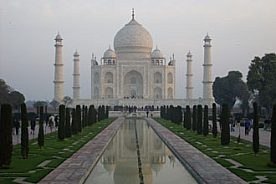
- 1-day and 6-day extension options available
- Add at the beginning or end of your holiday in India
- Sights include the Red Fort, Taj Mahal, City Palace and Amber Fort
After your adventures in India why not add an exciting day trip to Agra to see the sights of the one time capital of the great Mughal empire? Or, if you have more time available, perhaps a longer trip visiting both Agra and another gem of the ‘Golden Triangle’, Jaipur. Whichever option you take, once in Agra you will be looked after by one of our fully trained, English-speaking guides who will show you around the Red Fort, the Taj Mahal and the ancient city and mosque of Fatehpur Sikri. For those travelling on to Jaipur, you will take guided visits to the Amber Fort, Palace of the Winds and City Palace, along with time to explore the colourful bazaars of the ‘Pink City’.

- Corbett National Park is home to one of the largest Royal Bengal Tiger populations in India.
- Over 50 species of mammals, many reptiles and hundreds of bird species to look out for.
- Ideal extension from Delhi to explore some of India's most fascinating wildlife.
Corbett National Park is the oldest national park in India. Located between the Himalayan foothills to the north and the ancient Shivalik Hills to the south, the reserve covers a wide range of habitat with dense woodlands, open grasslands, riverine vegetation, dry riverbeds and more hilly terrain and so offers much diversity. This varied habitat hosts a spectacular diversity of mammal, bird and reptilian life, unmatched anywhere in India.
The park is home to one of the largest Royal Bengal Tiger populations in India as well as other large cats such as leopard. There are also around 50 species of mammals including large herds of elephant and four species of deer. In the park you also find many reptiles, including the rare and highly endangered Gharial crocodile. Corbett has a spectacular bird diversity – there are several hundred resident species of bird with as many more crossing on their migratory routes with bird diversity being at its peak during the winter months.
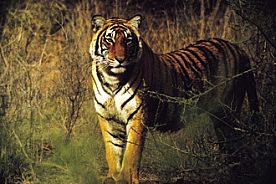
- Known for its population of tigers.
- Home to fascinating wildlife including jungle cats, hyenas, jackals, bears, crocodiles and large populations of langur monkeys.
- Enjoy safari drives as you look out for wildlife amongst the picturesque grassland, hills and lakes.
Ranthambore National Park in Rajasthan is one of the finest national parks in northern India. Formerly a hunting reserve for the Maharajas of Jaipur, you can see a huge variety of fantastic wildlife and birds in Ranthambore, but the park is particularly famous for its population of tigers - although of course sightings of tiger can never be guaranteed many visitors to this park are lucky enough to get good views. The scenery of the park is very varied with grassland, hills and lakes and there are also some very picturesque and atmospheric ruins located in the park. Even if you don’t see tigers there is abundant wildlife on view in Ranthambore with leopard and other cats such as jungle cats, caracal, hyena, jackal, wild boar, bear, several species of deer, and large populations of langur monkeys. Marsh crocodiles and other reptiles are also found in the lakes within the park. Owing to the wide range of habitats within the park there is also a large variety of fantastic and colourful birds, both resident and migrant, to be seen - in total, 272 bird species have been documented within the park.
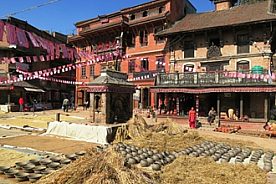
- Observe traditional crafts such as pottery, woodcarving and thangka painting
- Choose from a selection of full and half day guided tours
- Travel in a private car with a driver and an English-speaking guide
The Kathmandu Valley has a long and rich history and a vibrant culture and there is much that is worthwhile to see there - crowded bazaars, ancient temples, Buddhist stupas, crumbling shrines and picturesque palaces. The Malla kings who ruled in the valley created three major cities in the valley, Kathmandu, Bhaktapur and Patan and each of these cities has buildings that are showpieces for the art and architecture of local Newari craftsmen. We offer a selection of half day trips and full day trips to these sites the valley.


